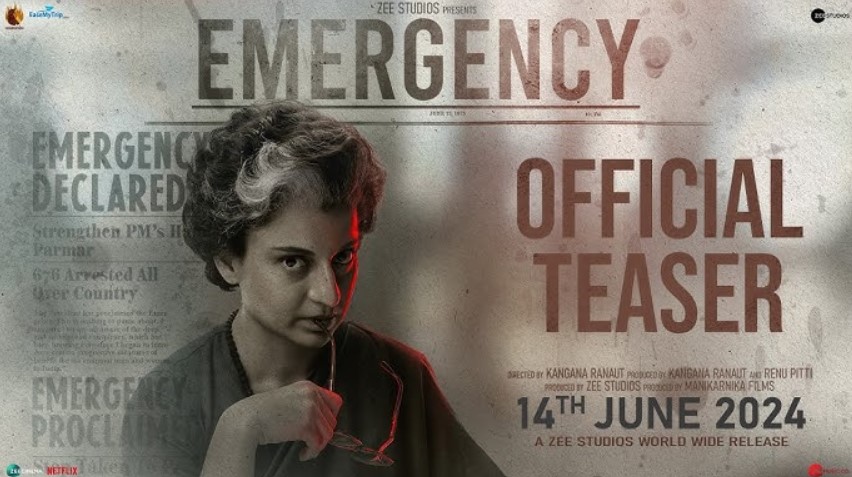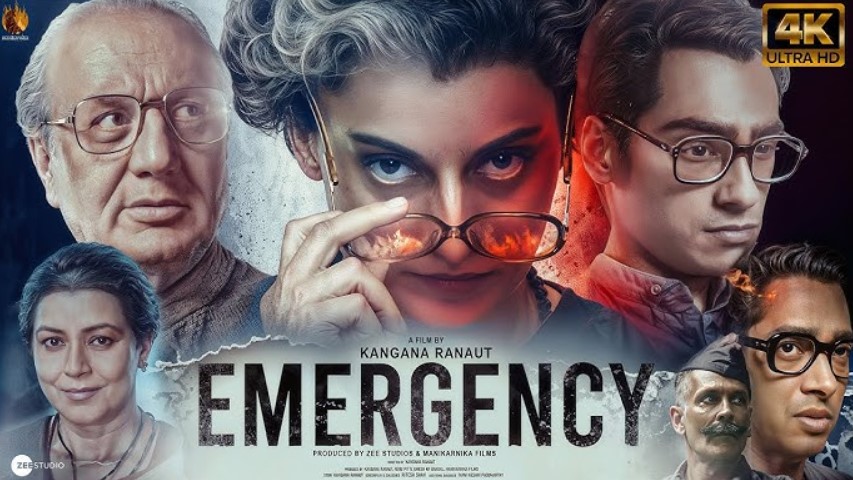
Director: Kangana Ranaut
Cast: Kangana Ranaut, Anupam Kher, Shreyas Talpade, Mahima Chaudhry, Milind Soman, Vishak Nair, Satish Kaushik
Genre: Political Drama
Duration: 150 minutes
Rating: ⭐⭐⭐
This film is a must-watch for its brilliant acting and visual appeal, but it falls short in doing justice to its title. For those seeking an in-depth depiction of one of India’s most controversial political periods, the movie might leave you wanting more.
Verdict
“Emergency 2025” is a bold attempt by Kangana Ranaut to bring one of India’s darkest political chapters to the big screen. The film shines in its performances, with Kangana delivering a masterful portrayal of Indira Gandhi, embodying her vulnerabilities, dilemmas, and inner strength, it falls short in delivering an authentic portrayal of key historical events.
One of the standout performances in the movie comes from Milind Soman as Indian Army Chief General Sam Manekshaw. His portrayal of the legendary Army officer is both charismatic and authentic, effectively capturing the essence of Sam Manekshaw’s persona. His entry in the film is one of the most impressive moments, and his interactions with Indira Gandhi are handled with precision, making his character memorable.
However, the movie takes significant creative liberties with historical accuracy. For instance, the opening sequence depicts Indira Gandhi traveling alone in a simple jeep to the North-East during the Indo-Sino War to prevent the exodus of people. This scene is dramatically powerful but highly unrealistic. Given that she was the daughter of the then-Prime Minister Pandit Jawaharlal Nehru and served as his unofficial personal assistant in the 1950s, such a scenario would have been impossible without adequate security measures. Furthermore, by the late 1950s, Indira Gandhi had already risen to prominence as the Congress Party president. Someone of her stature traveling alone during a war-like situation contradicts the protocols and risks associated with such a high-profile personality. This dramatization, while engaging for cinematic purposes, fails to align with historical and logistical realities.

The film’s depiction of Indira Gandhi as a confused and overly dependent leader further complicates its narrative. While it attempts to showcase her inner conflicts, it ends up portraying her as a “puppet Prime Minister,” heavily influenced by her son Sanjay Gandhi. Vishak Nair’s portrayal of Sanjay Gandhi effectively highlights his manipulative and authoritarian nature, but the film oversimplifies Indira Gandhi’s role in the decision-making process during the Emergency. Her character is shown as overly naive and innocent, which undermines her actual political acumen and decisiveness.
Another major shortcoming is the lack of focus on critical aspects of the Emergency. While the movie does touch upon significant events, the Emergency itself—the title’s central theme—feels rushed and underexplored. Key events such as the forced sterilizations, the mass arrests of opposition leaders, the censorship of the press, and the police brutality against students and junior leaders are either glossed over or depicted in a watered-down manner. The narrative fails to capture the socio-political chaos and fear that gripped the nation during this period.
Additionally, the depiction of Bindranwale raises more questions than answers. The film implies that Sanjay Gandhi had a major role in supporting Bindranwale’s rise after the Emergency was revoked. However, this is left unexplored, and the narrative skips over Operation Blue Star, a defining moment tied to the fallout of Bindranwale’s influence. The omission of such a significant event feels like a missed opportunity to delve deeper into the long-term consequences of the political strategies employed during the Emergency.
The limited portrayal of Feroze Gandhi’s role in the film is another glaring omission. Feroze Gandhi, known for his bold stance against corruption and his disagreements with Indira Gandhi’s strategies, especially during the Kerala crisis, could have added significant depth to the story. His relationship with Indira and their ideological differences would have provided a more nuanced understanding of her journey and struggles.
Despite these issues, the film is visually stunning, with breathtaking cinematography that captures pivotal moments like Indira’s introspection by the lakeside and her emotional turmoil. Milind Soman (as General Sam Manekshaw), Anupam Kher (as Jayaprakash Narayan), and Shreyas Talpade (as Atal Bihari Vajpayee) deliver performances that bring authenticity to their characters. However, the film misses the opportunity to delve deeper into the complexities of its subject matter.
In conclusion, “Emergency 2025” is a film that impresses with its performances and visuals but falters in its historical accuracy and focus. The title raises expectations of an in-depth exploration of the Emergency, but the narrative leans more toward Indira Gandhi’s personal dilemmas and Sanjay Gandhi’s dominance. The dramatization of certain events, like Indira Gandhi’s solitary journey to the North-East, and the oversimplification of her role during the Emergency, detract from the film’s authenticity.
Strengths and Weaknesses of Emergency 2025
Strengths:
1. Outstanding Performances:
- Kangana Ranaut delivers a powerful performance as Indira Gandhi, capturing her charisma, vulnerability, and political stature.
- Milind Soman as Sam Manekshaw stands out as one of the most impressive performances. His portrayal brings the legendary Army officer to life, leaving a lasting impact.
- Anupam Kher as Jayaprakash Narayan and Shreyas Talpade as Atal Bihari Vajpayee lend authenticity and gravitas to their roles.
2. Engaging Cinematography and Direction:
- Visually, the movie is stunning, with iconic moments like Indira Gandhi’s introspection by the lakeside, her meetings with senior leaders, and dramatic political confrontations.
- Kangana’s direction showcases her dedication and ambition in presenting a visually compelling narrative.
3. Memorable Characterizations:
- The portrayal of Sanjay Gandhi (Vishak Nair) as an authoritarian and manipulative figure adds an interesting layer to the story.
- Supporting characters like Mahima Chaudhry as Pupul Jayakar and Milind Soman enhance the narrative depth.
Weaknesses:
1. Underdeveloped Emergency Narrative:
- Despite the title, the film spends insufficient time on the Emergency itself. Critical aspects such as forced sterilizations, press censorship, and widespread police brutality are not given adequate focus.
- The Emergency period feels rushed and lacks the depth needed to portray its full socio-political impact.
2. Historical Inaccuracies and Dramatizations:
- Indira Gandhi traveling alone in a jeep to the North-East during the Indo-Sino War is highly unrealistic, given her position as the Prime Minister’s daughter and Congress Party president.
- The oversimplification of her character as a naive and confused leader undermines her actual political acumen.
3. Overemphasis on Sanjay Gandhi:
- Sanjay Gandhi’s character overshadows many other important aspects of the story. His role is exaggerated to portray him as the real decision-maker, making Indira Gandhi appear as a “puppet PM.”
- This imbalance diminishes the complexity of Indira’s leadership during the Emergency.
4. Omission of Key Figures and Events:
- The absence of Feroze Gandhi and his ideological disagreements with Indira is a major oversight. Their relationship and conflicts could have added depth to her character’s journey.
- Important historical events and figures, such as Indira’s role in the 1971 Bangladesh Liberation War, are underexplored.
5. Lack of Emotional Connection:
- While the film showcases Indira Gandhi’s dilemmas, it struggles to build a strong emotional connection with the audience regarding the impact of the Emergency on ordinary citizens.
6. Pacing Issues:
- The film sometimes feels uneven, with certain parts like the Emergency rushed while other segments focus excessively on Indira’s personal life and dilemmas.





